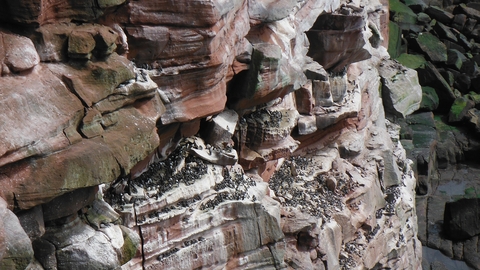
Cliff nesting seabirds at St Bees ©NWIFCA
Know before you go
Dogs
When to visit
Opening times
All year roundBest time to visit
June to AugustAbout the reserve
What makes St Bees so special?
The cliffs are home to the only colony of cliff-nesting seabirds in Northwest England, to which thousands of birds return each spring to lay their eggs and hatch their chicks before returning to the seas where they spend three-quarters of their lives. Most numerous are the black guillemots, the northern equivalent of the penguin; over 5,000 crowd on to the open ledges where they jostle for the best position to lay their single egg. Their close relative the razorbill is represented by only a few hundred birds, preferring the privacy of nooks and crannies in the cliffs. Among the fulmars, puffins, terns, cormorants, shags and various gulls, about 1600 pairs of kittiwakes build their precarious nests of mud and grass on the most meagre foundations on the cliff face. You should also look out for peregrine, sparrowhawk, tawny owl, raven, rock pipit and wheatear.
The rugged cliff face supports diverse flora. Species found lower down are sea pink or thrift, common scurvygrass, sea campion, sea spleenwort, rock samphire and the rare rock sea lavender. Near the cliff top is bloody cranesbill, wood vetch, orpine and soft shield-fern. Along the cliff top can be found dyer’s greenweed, western gorse, heather and bracken.
Amongst the rock pools you can find shore crabs, starfish, shrimp, mussels, dog whelks, limpets and winkles as well as a full range of wracks and other seaweeds. The rare honeycomb worm tries to establish itself among the rocks at the bottom of the cliffs. If you're lucky you may even spot a sunfish off the coast, as one lucky sea kayaker did in the summer of 2020.
What to do
Why not come along and have a walk at one of the two headllands. The RSPB owns most of the cliffs and they are a wonderful place for nesting birds. If you walk along the cliff path from The South Head, known locally as ‘Tomlin’ you will come to the remains of the coastguard lookout which now has a viewing table in its ruins. Further along you can find Fleswick Bay, a shingle beach enclosed by red sandstone cliffs. At one time you could find agates and other semi-precious stones amongst the shingle but years of collection by visitors have made these rare.
If you continue along the path to the North Head you will come to St Bees Lighthouse, which is still operating but unmanned. The rocks on the sea platform here are now a bouldering area used by climbers and there are a number of bolted climbing routes on the cliff itself.
